- Rugby Toolbox
- Resources & Education
- Learn more
- Articles
- Snook on Coaching
- Wrap Around Back Plays
- Ruck & Run Drill
- Playing Philosophy – Ruck & Run Coaching Components
- Playing Philosophy – Spread the Forwards
- Playing Philosophy – A forward behind the ruck
- Playing Philosophy – Ruck & Run
- Playing Philosophy – An idea!
- The Breakdown
- Building Positivity [3]
- Building Positivity [2]
- Building Positivity
- Fitness and Game Related Activities
- Getting the Head Working
- Missiles are Dangerous
- Use of Video
- Winger Attacking Outside First-Five
- Player Profiling
- Selection
- Fitness Away from the Team Session
- Playing Philosophy (Pre season Prep)
- Coaching the Coaches
- The Rugby Coordinator and Pre-Season Preparation
- Why Not Use Tap Penalties More Often?
- Why Kick the Ball Down the Middle of the Field?
- Defending the 5 Metre Lineout Drive
- Scoring from the 5 Metre Lineout
- What are the Kicking Team Aiming to Achieve from Halfway Restart
- Should We Practice Scoring Tries?
- Team Culture
- Looking After Your Players
- Coach Survival Tips
- Under 11/13 – Backline Defence
- Under 11/13 – Ruck Defence
- Under 11/13 – Back Attack
- Under 13 – The Counter Attack
- Under 11/13 – The Maul
- Under 11/13 – Lineouts
- Under 11/13 – Decision Making
- Under 11/13 – Support Play
- Under 11/13 – Dive Pass and More
- Under 11/13 – Drop & Grubber Kick /Highball Catch
- Under 11/13 – Front on Tackling
- Under 11/13 – Contact – Getting Up – The Ruck
- Under 11/13 – The Coaching Session
- Under 8/10 – Using Space
- Under 8/10 – Kicking
- Under 8/10 – Contact and Picking Up the Ball
- U8/U10 Draw & Pass and Sidestep
- Under 8/10 – The Tackle
- Under 8/10 – The Coaching Session
- Under 7 – Test Your Coaching – Support Play
- Tap Pass and Swerve U7
- Ball Familiarisation; Passing & Receiving
- Activities for the Non-Contact Tackle
- Under 7 – The Coaching Session
- Coaching Teenagers – After the Ruck
- Coaching Teenagers – The Practice Session
- Coaching Teenagers – Best Practice
- Coaching Kids – Best Practice
- Plays from a Tap Penalty
- Running Plays from a 5 Man Lineout
- Driving Plays from a 5 Man Lineout
- Strike Plays at the End of the Lineout
- Back Strike Plays at the Lineout
- Wide Strike at the Scrum (2)
- Wide Strike at the Scrum
- Midfield Attack at the Scrum
- No 8 Plays at the Scrum (2)
- No 8 Plays at the Scrum
- The Cut Out Pass
- Skills to Penetrate (2)
- Skills to Penetrate
- Movements to Penetrate
- Patterns to Penetrate
- Contact and Continuity
- Keeping the Ball Alive Out Wide
- Pre Season Support Activities
- Checklist
- Understanding the game
- The Playing Philosophy
- The Lineout
- Overview
- Team Profile
- Start Now!
- Backrow
- Nine and Ten
- Rugby-related Fitness Activities
- The Psychological Edge
- Open Field Play
- Key Performance Indicators
- Improving Team Performance
- Backline Attack Concepts
- Tactics at Phase Play
- Playing Philosophy
- The ‘Stop Focus’
- Kick Attack
- Clearing the 22
- Wide Attack at Phase
- Player Focus
- Scrum Preparation
- Lineout Preparation
- Back Attack Preparation
- Sevens Preparation
- Sevens Kick Offs
- Sevens Scrum and Lineout
- Sevens Attack Patterns
- Sevens Defence
- 7's Selection and Game Planning
- Coaching and Leadership
- How the Game Evolves
- Changing Within the Game
- Learning from the Television.
- Using Tap Penalties Wisely
- Defence Drills
- Defence Drills for Tight Five
- Team Defence and TUB’ing
- Establishing Patterns from the Ruck
- Structured Phase Play
- Structuring Phase Play on the Run
- Coaching Roles
- Structuring a Close in Tackling/Defensive Session
- Coaching in Threes
- Attacking Back Play
- Kick Off Chase
- Wrap Around Back Plays
- Lineout Plans
- Looking and Learning
- Motivating Your Players
- Scrum Attack
- Refocusing the Team
- Monitoring the Progress
- Learning the Game
- Playing to the Laws
- Small is OK
- Decisions After the Tackle
- Improving Your Coaching
- Food for Thought
- More Food for Thought
- Passing & Catching
- How Ireland Nearly Beat the All Blacks
- The Progressive Coach
- Try Something New
- Encouraging Excitement
- The Mental Approach
- Where to Start
- Being the Best You Can Be
- Off the Ball Decisions
- Lineouts Difficult to Master
- Decisions on the Run
- Rucking and Rolling
- A Successful Approach
- Gaining Clarity
- Manipulation vs Physicality
- Beating the Drift
- To Ruck or Not to Ruck
- Stopping the Lineout Drive
- Fine Tuning the Planning
- It's a Running Game
- RugbySmart 2015
- Using the Shoulders
- Loosehead Prop / Tighthead Prop
- Position Specific – Hooker
- Position Specific – Lock
- Position Specific – Blindside Flanker
- Position Specific – Openside Flanker
- Position Specific – No 8
- Position Specific – Halfback
- Position Specific – First Five Eighth
- Position Specific – Second Five Eighth
- Position Specific – Centre Three-quarter
- Position Specific – Wing
- Position Specific – Fullback
Wrap Around Back Plays
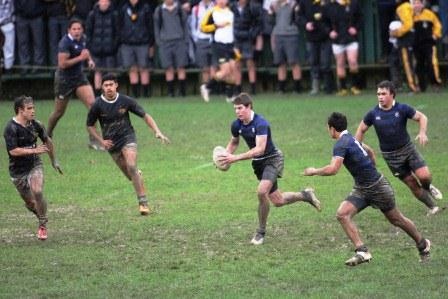
Wrap Around Back Plays
These plays were introduced to me by a Fijian International player when he was in the team I was coaching.
They obviously suit an athletic group of backline players and they do require a lot of accuracy and good decision making by each individual to make them work.
Still, there may be one particular play, or even a part of a play that you can work with your backline and the plays will introduce or reinforce the necessity of the ball going forward in the first instance, rather than lateral; the ball carrier being a threat but also passing before it is too late; the wrapping player hitting the ball at pace and straightening momentarily to stop the defender drifting; and the timing, change of pace and running lines of the outside players making sure they are threatening and not drifting across the field.
There is a lot to think about, but if you break the play in to a series of little parts and get each part sorted as you go, then the players will have a lot of fun and success. Make sure you get defensive players in on the play from the very beginning so that each attacker understands his role better and will make sure he is scanning forward so that his decision making is good. It will be a good idea to start in a deep enough formation which allows your players’ sufficient time and space relevant to their skill level / age.
Wrapping plays are about trying to create 2 v 1 situations so that numerically you have an advantage.
FM 10
This would work well if you have an attacking 12 who has already had a couple of cracks at breaking through on his own. Make sure he looks like he is going to ‘go for it’ again before he offloads. 13 should be watching his opposite number so that he can stay on the outside of him without running in to him. 10 will need to get the ball away to 15 either just in front of 13, or if it is behind it will need to be a bit earlier and a flat longish pass. 10 could well be the player scoring in the corner by keeping in support.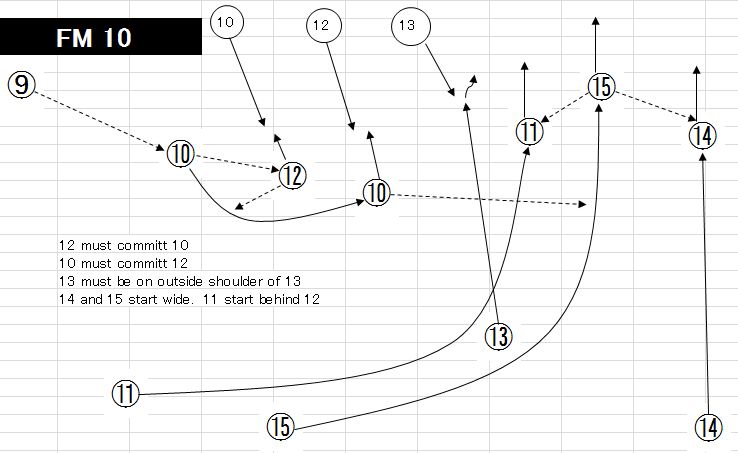
FM 12
10 passes to 13 who changes pace and running angle to look to force a gap outside D12. By 11 being on the inside of 13 he will may have a hole to run into between D10 and D12 or with a bit of luck D12 may even hold on him. 11 is a passing option from 13 where he would link with the backrow.
If 13 passes to 12, 12 needs to threaten D13, so he must be looking at the correct channel before receiving the pass which means he has gone early and straightened up while 13 is going forward inside him.
10 must be running quickly and get wide of and straighten up on 12. 12 then has an option of passing in front of 10 who has hopefully held an inside defender, or passing to 10. If 15 receives the ball he should have 10 in support on the inside and 14 on the outside. 12 should keep in support to score the try.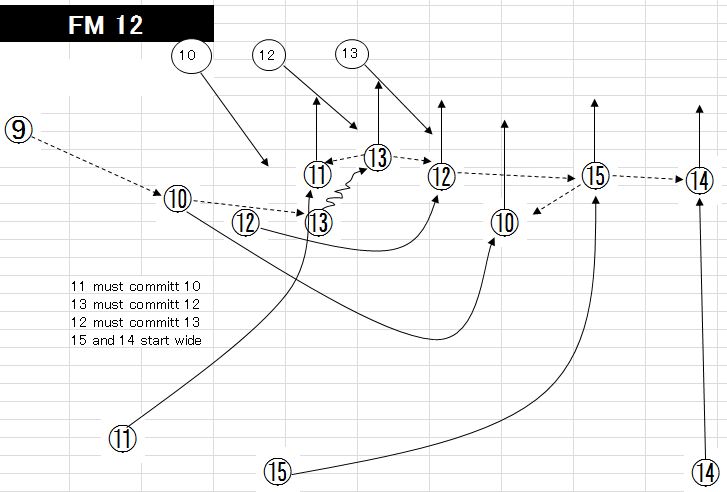
FM Majic
This has an extra loop thrown in so unless you have a very quick player at 10 and good thinkers at 12 and 13 it will be a difficult play to get underway. You could talk to your players about it and get them to practice it when they are warming up with their game of touch rugby. “One Touch” will ensure they have to operate quickly and skillfully.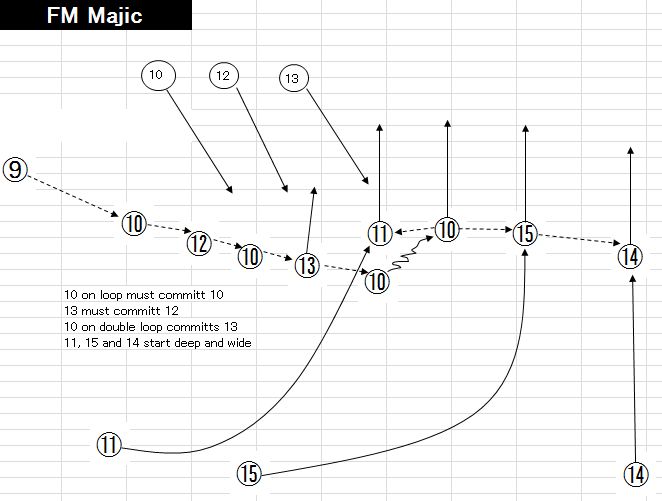
FM Dan
Obviously our Fijian player, and he was a goodie, was called Dan. Most of the time he played at 12 or 13 so this play was designed to get him in the game from a scrum by going left when D15 was tied up on the other side.
10 needs to be able to make a longish pass to 11 who needs to be running in balance rather than at full steam. 11 needs to be able to catch and pop the ball behind him to 12, who must wrap, straighten and accelerate. 13 will have gone early as well and 10 will need to get in the pocket as quickly as possible behind 13. 11 must support and it could well be the flying winger who make the final scoring act.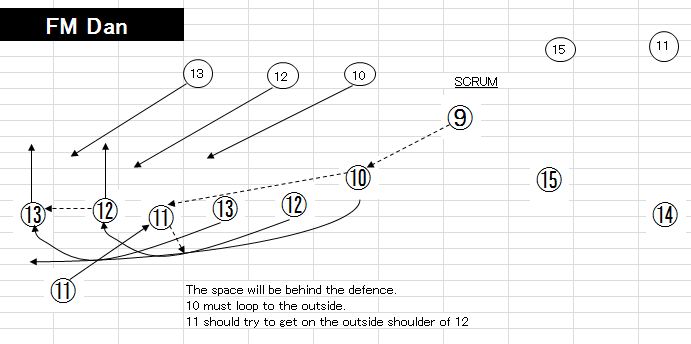
Good Luck!